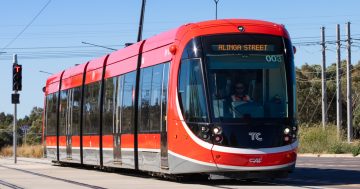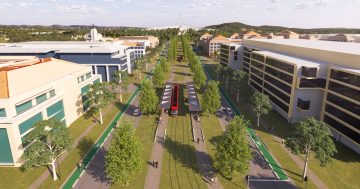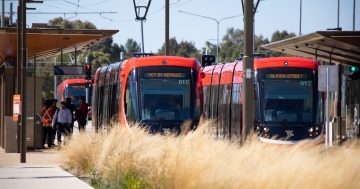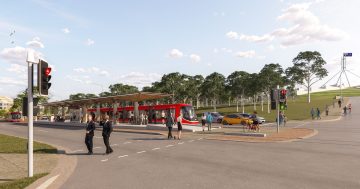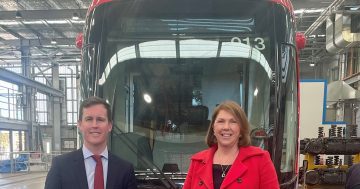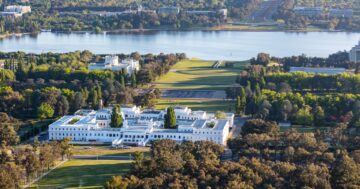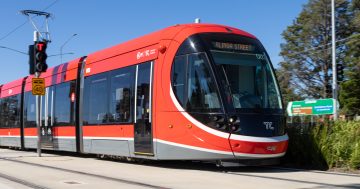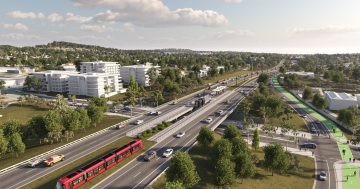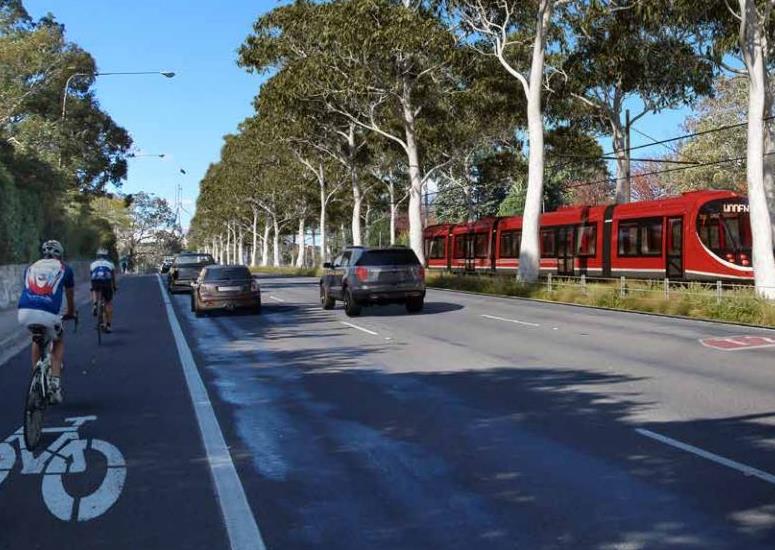
An artist’s impression of light rail on Adelaide Avenue. Photo: Supplied.
Concern appears to be mounting about the impact the preferred light rail Stage 2 route will have on southside commuters and the efficiency of the network as it grows, with a petition launched and some submissions to the current Parliamentary inquiry highlighting the issue.
Although still referred to as being part of the north-south spine, the Stage 2 route chosen by the ACT Government deviates through the Parliamentary zone’s employment and tourism centres on the way to Woden and will mean journey times of 25-30 minutes compared with current Blue Rapid bus times of 13-16 minutes. This will also affect northside commuters making their way to Woden.
Respondents to a survey last year during the public consultation favoured Stage 2 taking in Parkes and Barton, but travel times were not available at the time and the Government has been unclear about how light rail will affect rapid bus services between the City and Woden, apart from emphasising that there will be an integrated network.
The new bus network out for consultation already reduces rapid services between Woden and the City, with frequency cut from a peak-hour bus every two minutes to one every six minutes, which the Woden Valley Community Council (WVCC) says will mean commuters spending more time in interchanges.
“It is likely the tram (25-30 minutes) will take up to 15 minutes longer than the Blue Rapid (13 minutes off-peak, 16 minutes peak), an additional 30 minutes for the return trip from Woden to Civic, equals two and a half hours per week, equals up to 130 hours per year,” the WVCC says.
The WVCC has now launched a petition calling on the Legislative Assembly to:
- Ensure public transport travel times are maintained for residents living in Canberra’s south should a light rail from Woden to the City be built.
- Commit to a direct alignment (using the west side of State Circle to link Adelaide Avenue to Commonwealth Avenue) and extension of the track to Mawson.
- Provide for express services by reserving room in the corridor for a future third track.
“The light rail Stage 2 alignment from Gungahlin to Woden (via Barton) does not provide a direct, fast service for residents from the south of Canberra,” the petition says.
Its submission says consideration of the section through the Parliamentary Triangle should not be taken in isolation of the broader network and approvals should not be given without a thorough cost-benefit analysis.
“This also includes investigation of the benefits and costs of longer travel times for the backbone of Canberra’s public transport network by deviating through the Parliamentary Triangle. It also includes analysis of the origin/destination data and the patronage data for over 130,000 people in Tuggeranong, Woden and Weston,” it says.
The Griffith-Narrabundah Community Association also has concerns about journey times, as well as the impact of light rail construction on the Parliamentary Zone.

In its submission to the Parliamentary inquiry, the Association says the Government’s proposal for light rail to enter the heart of the Parliamentary zone should be rejected until the ACT Government provides a full business case that includes a rigorous social cost-benefit analysis.
It notes that Government has announced that a number of direct bus services from the northern suburbs into Civic will be discontinued, forcing passengers to change on to the tram at Dickson.
“The Committee should take into account any plans for a reduction in direct bus services from Woden Valley, Weston Creek and Tuggeranong to both Civic and the Parliamentary zone which would have a similarly adverse effect on workers travelling into the zone from the South,” the submission says.
Out Weston Creek way, the Community Council is asking what’s the benefit of light rail if the service is worse than the current bus network.
“Council would be concerned if the proposed light rail could not provide the same timetable and service for commuters. If the light rail cannot provide a similar service then what benefit can the light rail provide?” its submission says.
It is also concerned about the indirect nature of the Stage 2 preferred route through the Parliamentary zone and echoes calls for a cost-benefit analysis.
The Planning Institute of Australia (PIA), while supportive of light rail and acknowledging that servicing Barton has merit, says in its submission that it is not clear that the opportunities of the Barton deviation should be part of the Stage 2 North-South corridor project.
“PIA is concerned that by adopting the Barton deviation as part of Stage 2, the opportunity for a faster north-south corridor service will be foregone. The resulting function and role of the light rail system would be different. This potential departure from a more rapid transit role of the network should be further justified against the overarching city planning and transport objectives that surround the project,” it says.
It believes Barton could still be serviced without sacrificing the integrity of the north-south corridor.
There will be a public forum on Stage 2 at Eastlake Football Club in Griffith next Tuesday 10 July, at 7:00 pm.
Speakers and participants will include:
- CEO, National Capital Authority, Sally Barnes,
- Deputy Director-General, Transport Canberra, Duncan Edghill,
- Project Director, Light Rail Stage 2, Pam Nelson
- Senior Manager of (Bus) Network Systems and Service Performance, Peter Steele
The forum will discuss the implications of light rail for travel options, costs and benefits, urban development, heritage values, and open space.












